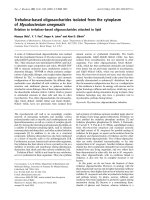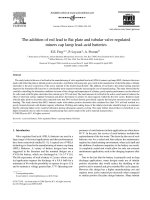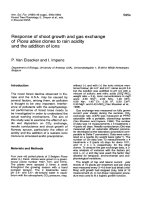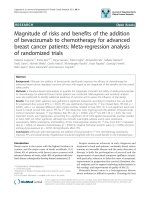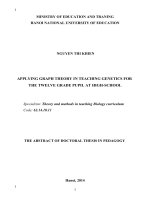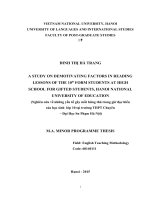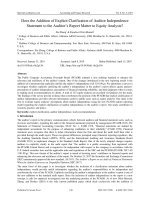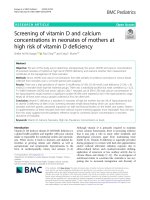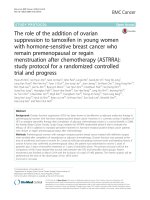Addition of Pullulan to Trehalose Glasses Improves the Stability of βGalactosidase at High Moisture Conditions
Bạn đang xem bản rút gọn của tài liệu. Xem và tải ngay bản đầy đủ của tài liệu tại đây (575.49 KB, 7 trang )
Carbohydrate Polymers 176 (2017) 374–380
Contents lists available at ScienceDirect
Carbohydrate Polymers
journal homepage: www.elsevier.com/locate/carbpol
Addition of Pullulan to Trehalose Glasses Improves the Stability of βGalactosidase at High Moisture Conditions
MARK
Naomi Teekamp, Yu Tian, J. Carolina Visser, Peter Olinga, Henderik W. Frijlink,
⁎
Herman J. Woerdenbag, Wouter L.J. Hinrichs
Department of Pharmaceutical Technology and Biopharmacy, University of Groningen, A. Deusinglaan 1, 9713 AV Groningen, The Netherlands,
A R T I C L E I N F O
A B S T R A C T
Keywords:
pullulan
trehalose
protein stabilization
sugar glass
dynamic vapor sorption
differential scanning calorimetry
Incorporation of therapeutic proteins in a matrix of sugar glass is known to enhance protein stability, yet protection is often lost when exposed to high relative humidity (RH). We hypothesized that especially in these
conditions the use of binary glasses of a polysaccharide and disaccharide might yield advantages for protein
stability. Therefore, different amounts of the polysaccharide pullulan were introduced in freeze-dried trehalose
glasses. In these homogeneous blends, the presence of pullulan above 50 weight % prevented crystallization of
trehalose when exposed to high RH. Storage stability testing up to 4 weeks of the model protein β-galactosidase
incorporated in pullulan/trehalose blends showed superior behavior of pure trehalose at 30 °C/0% RH, while
pullulan/trehalose blends yielded the best stability at 30 °C/56% RH. In conclusion, binary glasses of pullulan
and trehalose may provide excellent stability of proteins under storage conditions that may occur in practice,
namely high temperature and high RH.
1. Introduction
Proteins are becoming an increasingly relevant class of drugs in
today’s pharmacotherapy. Due to their size as well as their complex and
labile structure, ensuring stability of therapeutic proteins requires a
completely different formulation approach than for conventional small
molecule drugs (Manning, Chou, Murphy, Payne, & Katayama, 2010;
Mitragotri, Burke, & Langer, 2014). Generally, pharmaceutical proteins
are formulated as aqueous solutions, which have limited shelf life and
often require refrigerated storage and transportation. Next to the costs
and inconvenience involved with this so-called cold chain (Saxenian,
2017), proteins are often still subject to degradation. In case of impaired stability of proteins, not only their efficacy may be reduced, but
degradation products may also elicit undesired immune reactions, with
serious consequences for the patient (Jiskoot et al., 2012; Ratanji et al.,
2014). Conversely, by storing proteins in the dry state, the degradation
rate may be drastically reduced due to limited molecular mobility
(Lai & Topp, 1999). However, the stresses during drying and subsequent
storage could still impair their integrity (Mensink, Frijlink, van der
Voort Maarschalk, & Hinrichs, 2017). Therefore, appropriate protection
of the protein against such stresses, during both manufacturing and
storage, is necessary.
Sugars are widely used for the stabilization of proteins during
drying and subsequent storage. During the drying process, sugars enclose proteins in a glassy matrix yielding a so-called sugar glass. In
literature, there are two leading theories on the mechanism of stabilization of sugar glasses: the vitrification and water replacement theory
(Cicerone, Pikal, & Qian, 2015; Mensink et al., 2017). Upon vitrification
in a glassy matrix, the molecular mobility of proteins is strongly reduced, which in turn reduces degradation reaction rates (Chang et al.,
2005; Crowe et al., 1998). Next to this kinetic stabilization mechanism,
the water replacement theory has been proposed. This theory describes
protein stabilization based on thermodynamics. According to the water
replacement theory, the hydrogen bonds between the water molecules
in the hydration shell of the protein and the protein itself are (partially)
replaced by hydrogen bonds with the sugar (Allison, Chang,
Randolph, & Carpenter, 1999; Mensink et al., 2015). This replacement
conserves the three-dimensional structure of the protein. It is presumed
that these two mechanisms are not exclusive and they simultaneously
contribute to the stabilization of proteins (Crowe et al., 1998; Mensink
et al., 2017). For optimal stabilization according to both theories, a
close contact of the sugar with the protein and a high physical stability
of the carbohydrate matrix, i.e. a high glass transition temperature (Tg),
are required.
Abbreviations: BSA, bovine serum albumin; DSC, differential scanning calorimetry; DVS, dynamic vapor sorption; HEPES, 4-(2-hydroxyethyl)-1-piperazineethanesulfonic acid; RH,
relative humidity; Tg, glass transition temperature; Tg′, glass transition temperature of the maximally freeze concentrated fraction
⁎
Corresponding author.
E-mail address: (W.L.J. Hinrichs).
/>Received 6 June 2017; Received in revised form 15 August 2017; Accepted 18 August 2017
Available online 24 August 2017
0144-8617/ © 2017 The Author(s). Published by Elsevier Ltd. This is an open access article under the CC BY license ( />
Carbohydrate Polymers 176 (2017) 374–380
N. Teekamp et al.
2. Materials and methods
2.1. Materials
Pullulan (average molecular weight 200–300 kDa, < 10% mono-,
di- and oligosaccharides) was a kind gift of Hayashibara (Okayama,
Japan). Trehalose was obtained from Cargill (Amsterdam, The
Netherlands). β-galactosidase was purchased from Sorachim (Lausanne,
Switzerland). Bovine serum albumin (BSA), disodium hydrogen phosphate dodecahydrate, 4-(2-hydroxyethyl)-1-piperazineethanesulfonic
acid (HEPES), lithium chloride, magnesium chloride hexahydrate,
ortho-nitrophenyl-β-galactoside, monosodium phosphate dehydrate and
potassium acetate were purchased from Sigma Aldrich (Zwijndrecht,
The Netherlands). Ammonium chloride was obtained from SpruytHillen (IJsselstein, The Netherlands). Barium chloride was obtained
from Merck (Darmstadt, Germany). Sodium bromide was purchased
from Fagron (Capelle aan den IJssel, The Netherlands). Sodium nitrite
was purchased from Boom (Meppel, The Netherlands). Potassium carbonate was obtained from Acros Organics (Geel, Belgium).
All solutions were prepared using Millipore water. The 0.1 M
phosphate buffer used in this study consisted of 75 mM disodium hydrogen phosphate dodecahydrate and 25 mM monosodium phosphate
dihydrate; pH was adjusted to 7.3 using 1 M NaOH. The pH of 2 mM
HEPES buffer used in this study was set to 7.4.
Fig. 1. Chemical structure of pullulan.
Numerous types of sugars have been explored as protein stabilizers
(Chang et al., 2005; Hinrichs, Prinsen, & Frijlink, 2001; Tonnis et al.,
2015). For various reasons outlined below, we hypothesize that the
polysaccharide pullulan could be an attractive alternative. Pullulan is a
linear and neutral exopolysaccharide produced by the yeast Aureobasidium pullulans consisting of repeating α-1,4 linked maltotriose
units, which are connected by α-1,6 linkages (Fig. 1). Due to limited
molecular flexibility rising from the latter connection, the conformation
is believed to be random-coiled (Shingel, 2004). The molecular weight
of the chains can vary between 45 and 2000 kDa (Cheng,
Demirci, & Catchmark, 2011).
Over the last decades, pullulan has found various applications in the
food and pharmaceutical industries. It is a tasteless, odorless, non-toxic
and edible powder, and is generally regarded as safe. Pullulan readily
dissolves in water and the resulting solutions are not affected by heat
and pH changes (Prajapati, Jani, & Khanda, 2013). Therefore, pullulan
solutions have for example been applied as low-viscosity fillers in blood
plasma substitute solutions (Cheng et al., 2011; Prajapati et al., 2013).
Furthermore, pullulan and pullulan derivatives have been applied in
various drug delivery systems such as orodispersible films (Garsuch,
2009; Vuddanda et al., 2017), nanoparticles for protein delivery
(Dionisio et al., 2013), and targeted delivery systems to the liver (Xi
et al., 1996).
Although pullulan has many potential applications in drug delivery,
it has never been thoroughly investigated as a sugar glass for protein
stabilization. Yet, pullulan’s high Tg and the absence of reducing groups
would make it potentially an excellent candidate for protein stabilization. In fact, pullulan has been applied to enhance the stability of
protein assay components by casting tablets in an exploratory study
(Jahanshahi-Anbuhi et al., 2016). However, despite their high Tg,
polysaccharides often show less efficient protein stabilization than the
stabilization acquired by disaccharides, which have lower Tgs. Tonnis
et al. (2015) hypothesized that polysaccharides are too bulky to form a
compact coating around the protein. Furthermore, they also found that
the addition of a disaccharide to a polysaccharide can improve the
storage stability. This way, both a close contact between sugar and
protein and a high physical stability are ensured.
Considering the above, we hypothesize that the addition of pullulan
with its exceptionally high Tg to disaccharide glasses enhances the
protein stabilizing properties, particularly at high humidity. Trehalose
was selected as disaccharide as it has been well recognized as the gold
standard for protein stabilization (Balcão & Vila, 2014; Manning et al.,
2010). Firstly, physicochemical properties of pullulan and blends with a
wide range of pullulan/trehalose ratios were assessed, including their
behavior at conditions up to 90% relative humidity. Secondly, the
stability of a model protein (β-galactosidase) in pullulan and pullulan/
trehalose blends was tested at different temperature and humidity
conditions. The applied high humidity conditions were chosen to demonstrate the specific beneficial effects of polysaccharides, as opposed
to the low relative humidity conditions that are usually applied in
storage stability studies with disaccharide stabilized proteins.
2.2. Preparation of powder formulations
Pullulan and trehalose were accurately weighed and dissolved separately in water (dynamic vapor sorption and differential scanning
calorimetry measurements) or HEPES buffer (all other samples). Next,
the solutions were mixed in the following weight ratios of pullulan/
trehalose: 1/0; 5/1; 2/1; 1/1; 1/2; 1/5 and 0/1 (final sample concentration of 50 mg/mL). For the storage stability experiments, β-galactosidase dissolved in HEPES buffer was added to each combination in
a 1:249 protein:sugar weight ratio (final sample concentration of
50 mg/mL). As a negative control, a solution of β-galactosidase in
HEPES buffer without any sugar was used. The closed vial storage
stability samples were prepared in 4 mL vials, type I glass, Fiolax clear
(Schott, Müllheim, Germany), with corresponding rubber stoppers
(Salm & Kipp, Breukelen, The Netherlands). All other samples were
prepared in 2 mL polypropylene vials. The vials were then immersed in
liquid nitrogen to freeze the solutions and placed in a Christ-Epsilon 2-4
freeze-dryer (Salm & Kipp, Breukelen, The Netherlands) on a precooled
shelf (–50 °C). Next, the samples were freeze-dried at a shelf temperature of −35 °C and a pressure of 0.220 mbar for 24 h. Secondary drying
was performed by decreasing pressure to 0.050 mbar and increasing
shelf temperature to 25 °C during 24 h. After freeze-drying, the 4 mL
vials were closed under dry nitrogen gas to ensure 0% RH. Samples
were stored at −20 °C until further analysis or subjection to a storage
stability study.
2.3. Dynamic Vapor Sorption (DVS)
The water sorption isotherms of freeze-dried samples of all pullulan/trehalose compositions were determined using a DVS-1000
gravimetric sorption analyzer (Surface Measurement Systems Limited,
London, UK). Samples had an initial mass of about 10 mg and were
analyzed at ambient pressure and 25 °C. The water uptake by the sugar
blends was measured from 0% to 90% RH in 10% increments. The RH
was increased after equilibrium was achieved (change in mass < 0.5 μg
within 10 min).
375
Carbohydrate Polymers 176 (2017) 374–380
N. Teekamp et al.
independent experiments per time point). The remaining enzymatic
activity immediately after freeze-drying of β-galactosidase without
sugar, which was 83%, was used to relate all other activities to (normalization to 100%).
2.4. Differential Scanning Calorimetry (DSC)
The glass transition and crystallization behavior of freeze-dried
pullulan/trehalose blends was assessed using DSC. The Tg of the
maximally freeze concentrated fraction (Tg′) of pullulan/trehalose solutions was analyzed using a DSC 2920 (TA Instruments, Ghent,
Belgium). First, 40–50 mg of aqueous solution (45 mg/mL) was accurately weighed in open aluminum pans. Samples were analyzed without
lid. After placing in the DSC, the solution was frozen to −50 °C. Next,
the temperature was increased to 20 °C at a rate of 20 °C/min. The
inflection point in the heat flow versus temperature curve was taken as
the Tg′.
The Tg′ values for all blends were fitted using the Gordon-Taylor
equation:
Tg, mix ≈
2.6. Enzymatic activity of β-galactosidase
The enzymatic activity of β-galactosidase was determined using a
kinetic enzymatic assay, based on the conversion of the substrate orthonitrophenyl-β-galactoside (colorless) to ortho-nitrophenol (yellow) by
β-galactosidase. In brief, samples of 5 μg/mL were prepared in 50 mM
phosphate buffer supplemented with 0.1% BSA and 1 mM MgCl2. Next,
20 μL sample was pipetted into each well of a 96-well plate (Greiner, Fshape), followed by 200 μL MgCl2 solution (1.4 mM MgCl2 in 0.1 M
phosphate buffer, pH 7.3). The plate was incubated at 37 °C for 10 min
after which 20 μL of 50 mM ortho-nitrophenyl-β-galactoside was added
to the wells. The conversion to ortho-nitrophenol was determined by
measuring the absorbance at 405 nm every 30 s for 15 min at 37 °C
(Synergy HT Microplate Reader, BioTek Instruments, Winooski, VT).
The activity of β-galactosidase in units/mg was calculated from the
slope of this conversion.
ω1⋅Tg,1 + k ·ω2 ·Tg,2
(1)
ω1 + k ·ω2
where ωi is the mass fraction of component i, Tg,i the glass transition
temperature of component i and the constant k is a fitting parameter. In
our calculations, trehalose was taken as component 1 and pullulan as
component 2. To calculate the fitting parameter k, the water content
was considered as constant and was not incorporated in Eq. (1).
The Tg of anhydrous pullulan/trehalose blends was analyzed using a
Q2000 DSC (TA Instruments, Ghent, Belgium). An amount of 2 to 5 mg
of freeze-dried material was accurately weighed in open aluminum
pans. Samples were analyzed without lid. To remove residual water, the
samples were preheated at 70 °C for 5 min. After equilibration at 20 °C,
the temperature was raised to 300 °C at a rate of 20 °C/min. The Tg was
calculated as the inflection point of the heat flow versus temperature
curve. The Tg values for all blends were fitted using the Gordon-Taylor
equation (Eq. (1)).
The Tg of moisturized pullulan/trehalose blends, i.e. after 72 h exposure to different RH’s using saturated salt solutions (Table 1) at 25 °C,
was determined using a Q2000 DSC. An amount of 2 to 5 mg was accurately weighed in Tzero aluminum pans (TA Instruments, Ghent,
Belgium) and directly hermetically closed using a Tzero lid (TA Instruments, Ghent, Belgium). After equilibration at −20 °C for noncollapsed samples and −50 °C for collapsed samples, the temperature
was raised to 150 °C at a rate of 20 °C/min. Next, the samples were
cooled to the initial temperature at a rate of 20 °C/min and the first
heating step was repeated. Reported Tgs were calculated from the
thermograms of the second heating step. The inflection point in the heat
flow versus temperature curve was taken as the Tg.
2.7. Data analysis
All the data are represented as mean of n = 3 ± SD when applicable. The graphs and curve fittings were performed using Graphpad
Prism version 6.0 (GraphPad Prism Software, Inc., La Jolla, CA, USA).
3. Results
3.1. Water sorption
The vapor sorption isotherms of the different pullulan/trehalose
blends were comparable between 0% and 40% RH. At higher RH values, differences became apparent. Trehalose showed a maximum
weight gain at 50% RH of 12.4% (Fig. 2). At higher RH, the weight gain
slightly decreased to around 11.3%. This pattern is accordance with the
formation of the crystalline trehalose dehydrate (Costantino, Curley,
Wu, & Hsu, 1998; Hinrichs et al., 2001). The addition of 17% and 33%
pullulan delayed the crystallization of trehalose to 60% RH (Fig. 2).
Ultimately, at equal amounts of pullulan and trehalose, crystallization
of trehalose was fully prevented within the time frame of the experiment. At higher pullulan contents, similar behavior was observed and
trehalose did not crystallize (Fig. S1).
2.5. Storage stability testing
3.2. Glass transition Temperature (Tg)
The storage stability of β-galactosidase in pullulan/trehalose blends
and without sugar was assessed under different conditions. The storage
stability of closed vials was tested at 60 °C and 30 °C. Open vials were
used for storage stability testing at 30 °C and 56% RH, using a saturated
NaBr solution. The enzymatic activity of β-galactosidase was measured
immediately after freeze-drying and after 1, 2 and 4 weeks of storage (3
The thermograms of pullulan/trehalose solutions at all ratios
showed a single Tg′ (data not shown), which demonstrates the formation of a homogeneous blend of the two sugars in the maximally freeze
concentrated fraction. The Tg′ values of all blends were well above the
primary drying temperature of the freeze-drying process (Fig. 3a). No
Table 1
Relative humidity values over saturated salt solutions at 25 °C (Greenspan,
1977; Winston et al., 1960) used in this study.
Salt
Relative Humidity (%)
Lithium Chloride
Potassium Acetate
Magnesium Chloride
Potassium Carbonate
Sodium Bromide
Sodium Nitrite
Ammonium Chloride
Barium Chloride
11.3
22.5
32.8
43.2
57.6
64.0
78.6
90.0
Fig. 2. Vapor sorption isotherms of freeze-dried pullulan/trehalose blends at 25 °C.
376
Carbohydrate Polymers 176 (2017) 374–380
N. Teekamp et al.
formulations at pullulan/trehalose weight ratio of 0/1, 1/5 and 1/2 is
in agreement with the DVS measurements.
3.3. Storage stability
The stability of β-galactosidase, freeze-dried without sugar and in
different blends of pullulan/trehalose, was tested under different storage conditions. Without sugar, no activity loss was observed after
freeze-drying, however, a rapid decline in activity of β-galactosidase
was observed at 60 °C (Fig. 5a), with only 0.5% residual activity after 1
week. At 30 °C, the stability of β-galactosidase showed similar behavior
at both 0% and 56% RH conditions. As can be expected, the decrease in
activity was slower at 30 °C than at 60 °C. Nonetheless, after two weeks
the remaining enzymatic activity of β-galactosidase was only 3% for the
samples exposed to 56% RH and 14% for samples exposed to 0% RH
(Fig. 5a). After four weeks exposure to any of the tested conditions, the
remaining activity of β-galactosidase was negligible. All freeze-dried
formulations containing sugars performed better after four weeks of
storage than freeze-dried β-galactosidase without sugar (Fig. 5), indicating the stabilizing capabilities of both sugars regardless of their
ratios.
The process stability of freeze-drying β-galactosidase in pullulan/
trehalose blends was between 83% for pullulan only and gradually
increased with decreasing pullulan/trehalose ratios until 96% for trehalose only (Fig. 5b). During storage at any of the conditions, the enzymatic activity of β-galactosidase decreased in all formulations
(Fig. 5bcd). At 0% RH conditions, enzymatic activity loss was more
severe at higher temperature and higher pullulan content (Fig. 5bc).
Hence, the trehalose only formulation performed best in 0% RH conditions. In contrast, when exposed to 56% RH at 30 °C, the formulations
with a pullulan/trehalose weight ratio of 2/1, 1/1, 1/2 and 1/5 all
performed better than the trehalose only formulation (Fig. 5d). In
particular, the blends with pullulan/trehalose weight ratio 1/2 and 1/5
showed the same remaining activity of 76% and 83%, respectively,
compared to 0% RH, even though these formulations were collapsed
during storage. DSC measurements of pullulan/trehalose blends
without HEPES buffer and β-galactosidase exposed to 30 °C/56% RH
only showed crystallization of trehalose in the trehalose only formulation (Table S1). The Tgs of the formulations with a pullulan/trehalose
weight ratio of 1/2 and 1/5 were below storage temperature, i.e. 25.7
and 15.5 °C, respectively. It was assumed that the very small quantities
of HEPES buffer and β-galactosidase in the storage stability samples
(1.3 wt-% in total) had no effect on Tg.
Fig. 3. Glass transition temperatures of maximally freeze concentrated pullulan/trehalose
solutions Tg′ (a) and freeze-dried pullulan/trehalose blends Tg (b), fitted using the
Gordon-Taylor equation.
collapse was observed in any of the formulations after freeze-drying.
Fitting of the Tg′ values with the Gordon-Taylor equation yielded a k
value of 0.6818 (R2 = 0.9994).
Also, the thermograms of freeze-dried pullulan/trehalose solutions at
all ratios showed a single Tg (data not shown), indicating that the sugars
remained homogeneously mixed during drying. The Tg values of freezedried pullulan/trehalose blends are depicted in Fig. 2b. Pullulan showed
a Tg of 261 °C (Fig. 3b), which is substantially higher than (predicted)
values found elsewhere (Biliaderis, Lazaridou, & Arvanitoyannis, 1999;
Biliaderis, Lazaridou, Mavropoulos, & Barbayiannis, 2002; Diab,
Biliaderis, Gerasopoulos, & Sfakiotakis, 2001; Vuddanda et al., 2017).
This difference could be due to residual water or lower molecular weight
of the pullulan investigated. Trehalose showed a plasticizing effect on
pullulan and caused the Tg to drop with increasing weight fraction. The
Tg of freeze-dried trehalose was 121 °C (Fig. 3b), which is similar to
values found in literature (Tonnis et al., 2015; Vandenheuvel et al.,
2014). These values were fitted using the Gordon-Taylor equation and
resulted in a k value of 0.4163 (R2 = 0.9980).
Exposure of freeze-dried pullulan/trehalose blends to different RH
conditions (Table 1) during 72 h resulted in a decrease of the Tg in all
formulations (Fig. 4), which obviously can be ascribed to the plasticizing effect of adsorbed water. Collapse of some formulations was visually observed, with a trend towards increasing RHs and increasing
trehalose content. Formulations containing only pullulan did not collapse during exposure to any of the conditions. Some formulations that
were collapsed after exposure still showed a Tg (marked with * in
Fig. 4). However, for the remainder of the collapsed formulations partial or complete crystallization of trehalose occurred and no Tgs were
detectable (Table 2). The occurrence of crystallization in the
4. Discussion
In this study, we investigated the applicability of pullulan as (an
additive to) sugar glass matrices for stabilization of proteins by assessing various physicochemical properties of pullulan and pullulan/trehalose blends. In addition, we evaluated the storage stability of β-galactosidase, encapsulated in pullulan/trehalose blends, under different
temperature and humidity conditions. Our results show that pullulan
has some advantageous properties for protein stabilization, most importantly its very high Tg which amply remains above room temperature even when exposed to high RH. This was demonstrated by the
improved storage stability of the model protein β-galactosidase after
encapsulation in a pullulan sugar glass. The stability of the protein
could even be further improved by using a blend of trehalose with
pullulan as sugar glass matrix.
Since pullulan is a bulky molecule, it may not be able to provide for
an optimal molecular packing around proteins, thus preventing optimal
local vitrification and water replacement (Mensink et al., 2017), despite
the benefits of its high Tg. Basically, the application of a blend consisting of a small disaccharide and a large polysaccharide combines the
advantages of both a tight molecular packing (gaps left by the polysaccharide are filled by the disaccharide) (Tonnis et al., 2015) and a
377
Carbohydrate Polymers 176 (2017) 374–380
N. Teekamp et al.
Fig. 4. Glass transition temperatures (Tg) of pullulan/trehalose blends after 72 h exposure to different relative humidity conditions at 25 °C. Data
points marked with (*) indicate collapsed samples.
trehalose weight ratio of 1/1 indicated that trehalose crystallized when
exposed to 78.6% RH and higher while with DVS this effect was not
observed. Possibly, the high amount of water absorbed by pullulan
during DVS at high RHs concealed the crystallization pattern as seen
with other formulations using this method.
The process stability of the freeze-dried formulations clearly decreased with increased pullulan content. However, as mentioned above,
the steric hindrance caused by the large pullulan molecules may impair
a tight packing of the sugar around the protein. Consequently, the
protein might be less protected from stresses during freeze-drying.
Indeed, it has been shown that the addition of a disaccharide to large
polysaccharides results in an increase in process stability (Santagapita
et al., 2015) and a better preservation of protein secondary structure
after freeze-drying (Allison et al., 2000; Garzon-Rodriguez et al., 2004).
The storage stability results clearly show that trehalose is an optimal
stabilizer under condition free from any moisture (0% RH, closed vials)
at 30 °C and 60 °C, despite having the lowest Tg. This is in line with
earlier findings for dextran 70 kDa and trehalose blends (Tonnis et al.,
2015). In anhydrous conditions, the degree of vitrification of the protein in the sugar glass determines its stability. The vitrification is assumed to be best when the protein is tightly packed with sugar molecules, which would be the case for the disaccharide containing
formulations.
However, when moisture is present such as in the 56% RH/30 °C
condition we tested, trehalose did not perform best. The same was also
observed for trehalose/dextran 70 kDa systems (Santagapita et al.,
2015). Trehalose crystallization has been known to occur at RH values
of 45% at 25 °C (Diab et al., 2001) and higher temperatures (Jójártlaczkovich, Katona, Aigner, & Szabó-révész, 2016), and also at a low
temperature of 4 °C and 54% RH, trehalose crystallizes (Vandenheuvel
et al., 2014). From these previous studies, combined with the DVS and
DSC measurements of the present study, it can be concluded that the
trehalose only formulation crystallized at 30 °C/56% RH. It is well
known that a sugar loses its protective properties once it is crystallized
(Eriksson et al., 2002), and it is the most likely cause for the suboptimal
stabilization of trehalose when moisture is present. Here, we assume
that the presence of the protein and buffer did not disturb crystallization, which is highly plausible as these components are only present
in very small quantities (together 1.3 wt-% of the formulation).
At 56% RH/30 °C storage conditions, the formulations with a pullulan/trehalose weight ratio of 2/1, 1/1, 1/2 and 1/5 outperformed the
trehalose only formulation. This is in agreement with the DVS measurements of the blends with a pullulan/trehalose weight ratio of 2/1
Table 2
Crystallinity of trehalose in pullulan/trehalose blends after 72 h exposure to different
relative humidity conditions, expressed as a percentage. To calculate the percentage of
crystallized trehalose, the melting enthalpy of trehalose as determined by DSC was
compared to the melting enthalpy of fully crystalline trehalose. Values are corrected for
trehalose content in the formulations.
Pullulan/trehalose
43.2%
57.6%
64.0%
78.6%
90.0%
RH
RH
RH
RH
RH
1/1
1/2
1/5
0/1
0.0
0.0
0.0
53.0
56.1
0.0
0.0
6.7
61.6
69.2
0.0
0.0
78.5
84.1
83.3
2.8
96.6
99.8
105.3
96.5
high Tg (from the polysaccharide). These combinations of a polysaccharide and disaccharide have been described before (Allison et al.,
2000; Tonnis et al., 2015). Since disaccharides have a plasticizing effect
on polysaccharides, a high Tg of the polysaccharide is preferable to
maintain a high Tg after blending, especially because the Tg will additionally be affected by residual and absorbed water. Therefore, we
intended to “titrate” pullulan with trehalose to investigate the effects on
the physicochemical properties and to find an optimum blend composition for protein stabilization. We selected pullulan (200–300 kDa
average molecular weight) because we found that this polysaccharide
has an exceptionally high Tg of 261 °C compared to other polysaccharides: the Tgs of dextran 70 kDa and maltodextrin 19 kDa are
about 224 °C and 200 °C, respectively (Kilburn, Claude, Schweizer,
Alam, & Ubbink, 2005; Tonnis et al., 2015).
As expected, adsorbed water had a major plasticizing effect on the
pullulan/trehalose blends, which is reflected in decreased Tg values
(Fig. 4). It is noteworthy that the Tg of pullulan, even after exposure to
90% RH, remains well above room temperature. Also, it has become
apparent that collapse of samples consisting of the pullulan/trehalose
blend do not necessarily indicate trehalose crystallization, although the
Tg of these formulations dropped below room temperature and would
thereby probably impair protein stabilization. However, the possibility
that crystallization will occur upon longer exposure to high RH conditions cannot be excluded.
DVS was found to be an elegant method to predict crystallization of
trehalose in these binary glasses, as the DSC results and visual inspection of the samples exposed to different RHs generally correlated well
with the DVS results. However, DSC of the blend with a pullulan/
378
Carbohydrate Polymers 176 (2017) 374–380
N. Teekamp et al.
Fig. 5. Stability of freeze-dried β-galactosidase, with and without various pullulan/trehalose mixtures, at different storage conditions up to 4 weeks. Stability of freeze-dried β-galactosidase formulated without sugars during storage up to 4 weeks at 30 °C/56% RH, 30 °C/0% RH and 60 °C/0% RH (a). Process stability (no exposure) of β-galactosidase, freeze-dried
in different pullulan/trehalose blends and storage stability up to 4 weeks of these formulations at different conditions: 30 °C/0% RH (b), 60 °C/0% RH (c), and 30 °C/56% RH (d).
contributed to the stability.
and 1/1, which showed that the presence of pullulan prevented crystallization of trehalose, although these measurements were done at a
slightly lower temperature, i.e. 25 °C, than the storage stability study,
i.e. 30 °C. However, DSC measurements clearly showed that the Tgs of
the 2/1 and 1/1 pullulan/trehalose formulations were above storage
temperature (Table S1). Hence, these formulations remained in the
glassy state and therefore provided better protection than the trehalose
only formulation.
In contrast, blends with a pullulan/trehalose weight ratio of 1/2 and
1/5 had a Tg below storage temperature. These formulations were
found to collapse during exposure to 56% RH and 30 °C. Nevertheless,
under these humid conditions, the 1/2 and 1/5 blends remarkably
provided the best storage stability of β-galactosidase. The most likely
explanation would be that crystallization of trehalose was prevented or
delayed due to the presence of pullulan, which is supported by the DVS
measurements at 25 °C. In addition, the collapse and the absorbed
water may have caused a rearrangement of the sugar molecules other
than crystallization. Such molecular rearrangement potentially results
in tighter packing of sugar molecules around the protein than before
collapse, thereby providing excellent stability of the protein by improved water replacement. This may imply that in this particular case
vitrification of the protein is of secondary importance. Furthermore, the
stabilizing capacity of these formulations is in agreement with the work
of Schersch and coworkers, who showed that the long term stability of
several proteins was only slightly affected in intentionally collapsed
amorphous cakes using collapse-drying (Schersch et al., 2010, 2013).
Obviously, the protective properties of pullulan itself may also have
5. Conclusion
The assessment of the biocompatible polysaccharide pullulan (Mw
200–300 kDa) as a sugar glass for protein stabilization yielded a very
high Tg of 261 °C, which is an excellent attribute for protein stabilization. Yet, pullulan’s bulky nature prevents a tight molecular packing
around proteins, which resulted in a process and storage stability of the
model protein β-galactosidase that was inferior to the disaccharide
trehalose at conditions free from moisture (0% RH). However, when
moisture is present (e.g. 56% RH), as may occur in daily practice, blends
of pullulan and trehalose outperformed trehalose alone. Under these
conditions, the presence of pullulan increased the Tg of the formulations
compared to trehalose alone and furthermore, pullulan prevented
crystallization of trehalose. Hence, pullulan/trehalose blends combine
the strengths of both sugars, namely the high Tg of pullulan and the
tight molecular packing of trehalose. Altogether, our results show the
potential of pullulan/trehalose blends for application as a pharmaceutical excipient in stabilizing proteins in solid form.
Acknowledgements
The authors thank Michelle Wijma for her preliminary work on the
characterization of pullulan. This work was supported by The Northern
Netherlands Province Alliance (grant number T2002) and the China
Scholarship Council.
379
Carbohydrate Polymers 176 (2017) 374–380
N. Teekamp et al.
clinical application of injectable protein delivery systems for sustained release.
Journal of Pharmaceutical Sciences, 101(3), 946–954.
Jójárt-laczkovich, O., Katona, G., Aigner, Z., & Szabó-révész, P. (2016). Investigation of
recrystallization of amorphous trehalose through hot-humidity stage X-ray powder
diffraction. European Journal of Pharmaceutical Sciences, 95, 145–151.
Kilburn, D., Claude, J., Schweizer, T., Alam, A., & Ubbink, J. (2005). Carbohydrate
polymers in amorphous states: An integrated thermodynamic and nanostructural
investigation. Biomacromolecules, 6(2), 864–879.
Lai, M. C., & Topp, E. M. (1999). Solid-state chemical stability of proteins and peptides.
Journal of Pharmaceutical Sciences, 88(5), 489–500.
Manning, M. C., Chou, D. K., Murphy, B. M., Payne, R. W., & Katayama, D. S. (2010).
Stability of protein pharmaceuticals: an update. Pharmaceutical Research, 27(4),
544–575.
Mensink, M. A., Frijlink, H. W., van der Voort Maarschalk, K., & Hinrichs, W. L. J. (2017).
How sugars protect proteins in the solid state and during drying (review):
Mechanisms of stabilization in relation to stress conditions. European Journal of
Pharmaceutics and Biopharmaceutics, 114, 288–295.
Mensink, M. A., Van Bockstal, P.-J., Pieters, S., De Meyer, L., Frijlink, H. W., van der Voort
Maarschalk, K., ... De Beer, T. (2015). In-line near infrared spectroscopy during
freeze-drying as a tool to measure efficiency of hydrogen bond formation between
protein and sugar, predictive of protein storage stability. International Journal of
Pharmaceutics, 496(2), 792–800.
Mitragotri, S., Burke, P. A., & Langer, R. (2014). Overcoming the challenges in administering biopharmaceuticals: formulation and delivery strategies. Nature Reviews Drug
Discovery, 13(9), 655–672.
Prajapati, V. D., Jani, G. K., & Khanda, S. M. (2013). Pullulan: An exopolysaccharide and
its various applications. Carbohydrate Polymers, 95(1), 540–549.
Ratanji, K. D., Derrick, J. P., Dearman, R. J., & Kimber, I. (2014). Immunogenicity of
therapeutic proteins: Influence of aggregation. Journal of Immunotoxicology, 11(2),
99–109.
Santagapita, P. R., Mazzobre, M. F., Buera, M. P., Ramirez, H. L., Brizuela, L. G., Corti, H.
R., & Villalonga, R. (2015). Impact of supramolecular interactions of dextran-β-cyclodextrin polymers on invertase activity in freeze-dried systems. Biotechnology
Progress, 31(3), 791–798.
Saxenian, H., (2017). Immunization financing: a resource guide for advocates, policymakers, and program managers. Resource Guide by Results for Development
Institute: Washington, DC.
Schersch, K., Betz, O., Garidel, P., Muehlau, S., Bassarab, S., & Winter, G. (2010).
Systematic Investigation of the Effect of Lyophilizate Collapse on Pharmaceutically
Relevant Proteins I: Stability after Freeze-Drying. Journal of Pharmaceutical Sciences,
99, 2256–2278.
Schersch, K., Betz, O., Garidel, P., Muehlau, S., Bassarab, S., & Winter, G. (2013).
Systematic investigation of the effect of lyophiizyte collapse on pharamceutically
relevant proteins III: Collapse during storage at elevated temperatures. European
Journal of Pharmaceutics and Biopharmaceutics, 85(2), 240–252.
Shingel, K. I. (2004). Current knowledge on biosynthesis, biological activity, and chemical modification of the exopolysaccharide, pullulan. Carbohydrate Research,
339(3), 447–460.
Tonnis, W. F., Mensink, M. A., de Jager, A., van der Voort Maarschalk, K., Frijlink, H. W.,
& Hinrichs, W. L. J. (2015). Size and Molecular Flexibility of Sugars Determine the
Storage Stability of Freeze-Dried Proteins. Molecular Pharmaceutics, 12(3), 684–694.
Vandenheuvel, D., Meeus, J., Lavigne, R., & Van Den Mooter, G. (2014). Instability of
bacteriophages in spray-dried trehalose powders is caused by crystallization of the
matrix. International Journal of Pharmaceutics, 472(1–2), 202–205.
Vuddanda, P. R., Montenegro-Nicolini, M., Morales, J. O., & Velaga, S. (2017). Effect of
plasticizers on the physico-mechanical properties of pullulan based pharmaceutical
oral films. European Journal of Pharmaceutical Sciences, 96, 290–298.
Winston, P. W., Bates, D. H., Ecology, S., Jan, N., Bovbjerg, R. V., & Glynn, P. W. (1960).
Saturated Solutions For the Control of Humidity in Biological Research. Ecology,
41(1), 232–237.
Xi, K., Tabata, Y., Uno, K., Yoshimoto, M., Kishida, T., Sokawa, Y., & Ikada, Y. (1996).
Liver targeting of interferon through pullulan conjugation. Pharmaceutical Research.
Appendix A. Supplementary data
Supplementary data associated with this article can be found, in the
online version, at />References
Allison, S. D., Chang, B., Randolph, T. W., & Carpenter, J. F. (1999). Hydrogen bonding
between sugar and protein is responsible for inhibition of dehydration-induced protein unfolding. Archives of Biochemistry and Biophysics, 365(2), 289–298.
Allison, S. D., Manning, M. C., Randolph, T. W., Middleton, K., Davis, A., & Carpenter, J.
F. (2000). Optimization of storage stability of lyophilized actin using combinations of
disaccharides and dextran. Journal of Pharmaceutical Sciences, 89(2), 199–214.
Balcão, V. M., & Vila, M. M. D. C. (2014). Structural and functional stabilization of protein
entities: state-of-the-art. Advanced Drug Delivery Reviews, 93, 25–41.
Biliaderis, C. G., Lazaridou, A., & Arvanitoyannis, I. (1999). Glass transition and physical
properties of polyol-plasticized pullulan-starch blends at low moisture. Carbohydrate
Polymers, 40(1), 29–47.
Biliaderis, C. G., Lazaridou, A., Mavropoulos, A., & Barbayiannis, N. (2002). Water
plasticization effects on crystallization behavior of lactose in a co-lyophilized amorphous polysaccharide matrix and its relevance to the glass transition. International
Journal of Food Properties, 5(2), 463–482.
Chang, L., Shepherd, D., Sun, J., Ouellette, D., Grant, K. L., Tang, X., & Pikal, M. J. (2005).
Mechanism of protein stabilization by sugars during freeze-drying and storage:
Native structure preservation, specific interaction, and/or immobilization in a glassy
matrix? Journal of Pharmaceutical Sciences, 94(7), 1427–1444.
Cheng, K. C., Demirci, A., & Catchmark, J. M. (2011). Pullulan: Biosynthesis, production,
and applications. Applied Microbiology and Biotechnology, 92(1), 29–44.
Cicerone, M. T., Pikal, M. J., & Qian, K. K. (2015). Stabilization of proteins in solid form.
Advanced Drug Delivery Reviews, 93, 14–24.
Costantino, H. R., Curley, J. G., Wu, S., & Hsu, C. C. (1998). Water sorption behavior of
lyophilized protein-sugar systems and implications for solid-state interactions.
International Journal of Pharmaceutics, 166(2), 211–221.
Crowe, J. H., Carpenter, J. F., & Crowe, L. M. (1998). The Role of Vitrification in
Anhydrobiosis. Annu. Rev. Physiol. 60, 73–103.
Diab, T., Biliaderis, C. G., Gerasopoulos, D., & Sfakiotakis, E. (2001). Physicochemical
properties and application of pullulan edible films and coatings in fruit preservation.
Journal of the Science of Food and Agriculture, 81(10), 988–1000.
Dionisio, M., Cordeiro, C., Remunan-Lopez, C., Seijo, B., Da Costa, A. M. R., & Grenha, A.
(2013). Pullulan-based nanoparticles as carriers for transmucosal protein delivery.
European Journal of Pharmaceutical Sciences, 50(1), 102–113.
Eriksson, H. J. C., Hinrichs, W. L. J., Van Veen, B., Somsen, G. W., De Jong, G. J., &
Frijlink, H. W. (2002). Investigations into the stabilisation of drugs by sugar glasses: I.
Tablets prepared from stabilised alkaline phosphatase. International Journal of
Pharmaceutics, 249(1–2), 59–70.
Garsuch, V. I. (2009). Preparation and characterization of fast-dissolving oral films for pediatric use. Düsseldorf: Heinrich-Heine University.
Garzon-Rodriguez, W., Koval, R. L., Chongprasert, S., Krishnan, S., Randolph, T. W.,
Warne, N. W., & Carpenter, J. F. (2004). Optimizing Storage Stability of Lyophilized
Recombinant Human Interleukin-11 with Disaccharide/Hydroxyethyl Starch
Mixtures. Journal of Pharmaceutical Sciences, 93(3), 684–696.
Greenspan, L. (1977). Humidity Fixed Points of Binary Saturated Aqueous Solutions.
Journal of Research of the National Bureau of Standards – A. Physics and Chemistry,
81A(1).
Hinrichs, W. L., Prinsen, M. G., & Frijlink, H. W. (2001). Inulin glasses for the stabilization
of therapeutic proteins. International Journal of Pharmaceutics, 215(1–2), 163–174.
Jahanshahi-Anbuhi, S., Kannan, B., Leung, V., Pennings, K., Liu, M., Carrasquilla, C., ...
Filipe, C. D. M. (2016). Simple and ultrastable all-inclusive pullulan tablets for
challenging bioassays. Chem. Sci. 7(3), 2342–2346.
Jiskoot, W., Randolph, T. W., Volkin, D. B., Middaugh, C. R., Schöneich, C., Winter, G., ...
Carpenter, J. F. (2012). Protein instability and immunogenicity: Roadblocks to
380

